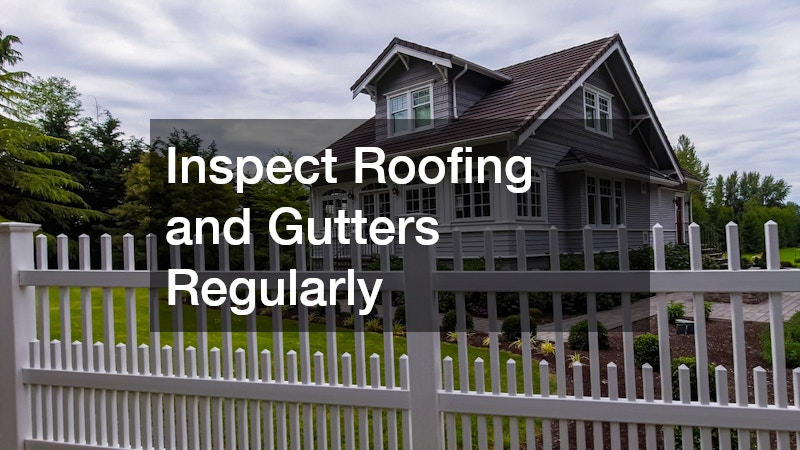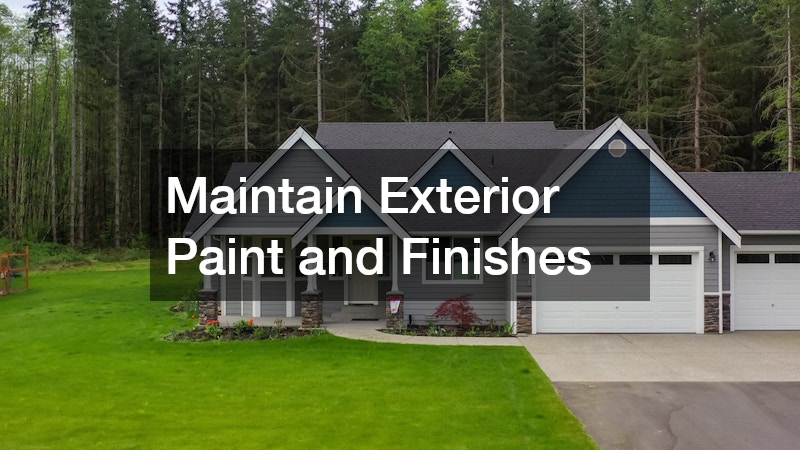Updating the Outside of Your Home
Residential exterior maintenance is an essential part of preserving the beauty, safety, and functionality of a home. Over time, exposure to the elements can wear down even the most durable materials, leading to costly repairs if left unchecked. By developing a proactive maintenance routine, homeowners can protect their investment, extend the lifespan of exterior features, and improve overall curb appeal. From the roof to the landscaping, every component of a home’s exterior plays a role in shielding the property from damage and ensuring it remains a welcoming and comfortable place to live.
A well-structured maintenance checklist not only helps homeowners stay organized but also ensures that no critical areas are overlooked. It allows for a consistent schedule, helping to catch small problems before they escalate. Addressing tasks such as inspecting roofing, cleaning siding, or sealing windows can have a major impact on a home’s condition. With a thoughtful approach to residential exterior maintenance, it’s possible to keep the property looking fresh while preventing issues that could compromise its structural integrity.
Beyond the immediate benefits, regular upkeep can also contribute to long-term cost savings. Minor issues, when ignored, can lead to significant repairs that require much more time and money to address. Preventive care reduces the likelihood of sudden emergencies, such as roof leaks or structural damage, which can disrupt daily life. Moreover, a well-maintained exterior can increase property value, making the home more appealing to potential buyers should the homeowner decide to sell. Curb appeal often serves as the first impression, and a home that looks cared for can stand out in a competitive housing market.

Inspect Roofing and Gutters Regularly
The roof and gutter system are a home’s first line of defense against rain, wind, and other harsh weather conditions. Regular inspections help identify signs of damage, such as loose shingles, leaks, or debris buildup, before they develop into serious problems. Clogged gutters, in particular, can cause water to overflow and pool around the foundation, increasing the risk of structural damage and basement flooding. By incorporating roof and gutter checks into a residential exterior maintenance routine, homeowners can safeguard their property against these common issues.
When inspecting, pay attention to the condition of flashing around chimneys, vents, and skylights, as well as any sagging sections of gutters. An HVAC company can sometimes assist in identifying related ventilation concerns that may affect roof performance. It’s also wise to clear out leaves, dirt, and other blockages at least twice a year, ideally in the spring and fall. Addressing these maintenance tasks promptly can prevent moisture infiltration, preserve the roof’s lifespan, and help maintain the home’s energy efficiency.
In addition to visual inspections, homeowners may benefit from scheduling a professional roof assessment every few years. Experts can spot hidden damage that may not be visible from the ground, such as soft spots caused by rot or subtle signs of wear in roofing materials. These early detections allow for small repairs before they escalate into larger, more costly issues. Preventive maintenance also ensures that roofing systems remain compliant with manufacturer warranties, which often require proof of regular care to remain valid.
Clean and Repair Siding as Needed
Siding serves as both an aesthetic feature and a protective barrier for a home’s structure. Over time, dirt, mold, mildew, and environmental pollutants can accumulate, causing the siding to lose its appeal and potentially degrade. As part of residential exterior maintenance, routine cleaning can help restore the siding’s original look while preventing deterioration. Repairs to cracked, warped, or missing panels are also important to maintain the home’s insulation and protection against pests and water intrusion.
Different siding materials, such as vinyl, wood, or fiber cement, may require specific cleaning and repair techniques. Pressure washing can be effective for many types, but it’s important to use the right settings to avoid damage. In some cases, plumbing contractors may discover water-related damage during service calls, which can point to issues with siding integrity. Addressing these problems early ensures that the home remains visually appealing and structurally sound, while also improving its ability to withstand seasonal weather changes.
A deeper level of care involves inspecting siding for less obvious signs of wear, such as fading color, bubbling paint, or small gaps at panel joints. These issues can allow moisture to penetrate, which may lead to rot, mold growth, or compromised insulation. When caught early, targeted repairs can often be made without replacing large sections, saving time and expense. It’s also wise to check for insect activity, as certain pests can burrow behind siding, causing hidden damage.

Maintain Exterior Paint and Finishes
A home’s exterior paint and finishes do more than enhance its curb appeal—they provide a critical protective layer against weather, UV rays, and moisture. Over time, paint can peel, fade, or crack, leaving surfaces vulnerable to damage. Regularly inspecting painted areas and touch-ups as needed should be part of any residential exterior maintenance plan. Fresh paint or sealant not only refreshes the home’s appearance but also extends the lifespan of siding, trim, and other exterior materials.
When planning a repaint, choose high-quality, weather-resistant products that match your home’s needs and climate. Pay attention to areas exposed to the most sun or rain, as they tend to deteriorate faster. Air conditioning services can also be a factor, as condensation from exterior units may cause moisture buildup that damages nearby paint or finishes. Addressing these areas promptly keeps your home looking sharp while maintaining its protective barrier against the elements.
Check and Seal Windows and Doors
Windows and doors play an essential role in energy efficiency, comfort, and weather protection. Over time, seals and caulking can deteriorate, allowing drafts, moisture, and pests to enter. Regularly inspecting and sealing these openings is an important step in residential exterior maintenance, as it helps reduce utility bills, prevent water damage, and enhance indoor comfort. Replacing damaged weather stripping can also make a noticeable difference in performance.
Seasonal checks are especially valuable before the onset of extreme temperatures. Look for gaps, cracks, or worn-out caulk, and reseal where necessary to maintain a tight barrier. A hot tub contractor may point out issues with nearby windows or doors if excess moisture from outdoor installations is contributing to wood rot or seal damage. These small repairs, when done consistently, can significantly prolong the lifespan of your windows and doors while improving overall energy efficiency.

Service HVAC Units and Vents
The exterior components of your home’s HVAC system are just as important to maintain as the indoor units. Outdoor condensers, vents, and related equipment can accumulate dirt, leaves, and other debris, which may restrict airflow and strain the system. Incorporating HVAC servicing into a residential exterior maintenance schedule helps keep the system running efficiently, extending its life and reducing the likelihood of costly breakdowns.
Routine maintenance should include clearing debris from around the unit, inspecting vent covers, and checking for signs of wear or damage. Having these tasks performed regularly not only improves system performance but can also prevent energy waste. Tree removal services may be necessary if overhanging branches are dropping leaves or causing obstructions near the HVAC unit. Keeping this area clean and clear is essential to ensuring consistent operation and maintaining indoor comfort year-round.
Trim Trees and Shrubs Around the Home
Overgrown trees and shrubs can cause a range of problems for a property if not properly managed. Branches too close to the home can damage roofing, siding, and gutters during storms, while dense foliage may trap moisture against exterior walls. As part of a regular residential exterior maintenance routine, trimming plants back from the house helps prevent damage, improves air circulation, and enhances the overall appearance of the yard. Healthy landscaping also reduces the risk of pests finding easy access points into the home.
When trimming, focus on removing dead or diseased branches and maintaining a safe clearance between vegetation and the structure. This is especially important near roofs, windows, and utility lines. Backflow testing professionals may also recommend keeping shrubs and trees away from irrigation and plumbing fixtures to reduce the chance of root interference. By keeping landscaping neat and properly spaced, homeowners protect both their home’s structure and its curb appeal.

Clean and Repair Driveways and Walkways
Driveways and walkways are not only functional elements but also key parts of a home’s exterior presentation. Over time, they can develop cracks, stains, or uneven surfaces due to weather, heavy use, and natural wear. Including these areas in a residential exterior maintenance plan helps prevent safety hazards, improve accessibility, and maintain an inviting appearance. Regular cleaning removes dirt and debris, while timely repairs address structural concerns before they worsen.
Different surfaces require different care, whether it’s pressure washing concrete, resealing asphalt, or replacing broken pavers. A hardscaping company can assist with more complex repairs or redesigns to improve durability and aesthetics. By maintaining these surfaces, homeowners can avoid costly overhauls, keep outdoor areas safe for walking, and ensure that the home’s entryways remain attractive and functional year-round.
Inspect and Maintain Decks and Patios
Decks and patios serve as extensions of a home’s living space, offering areas for relaxation and entertainment. However, exposure to sunlight, moisture, and temperature changes can cause wear, leading to fading, rot, or structural issues over time. Incorporating deck and patio upkeep into a residential exterior maintenance plan helps preserve these spaces’ beauty, safety, and usability. Regular inspections can identify loose boards, cracked pavers, or rusted fasteners that need attention.
Seasonal maintenance often involves cleaning, sealing, and making minor repairs to prevent long-term damage. Wooden decks may need staining or sealing every couple of years to protect against moisture and UV rays. An electrical contractor may be consulted if outdoor lighting or outlets require updates to ensure safety and compliance. With consistent care, decks and patios can remain comfortable, attractive, and structurally sound for years to come.
Test Outdoor Lighting and Electrical Fixtures
Outdoor lighting and electrical fixtures play a crucial role in safety, security, and curb appeal. Over time, bulbs can burn out, wiring can deteriorate, and fixtures may suffer weather-related damage. Including these elements in a residential exterior maintenance plan ensures that pathways are well-lit, security systems function properly, and decorative lighting enhances the home’s appearance. Functional lighting also helps prevent accidents by illuminating steps, walkways, and driveways.
Regularly check for loose connections, water damage, or exposed wiring that could pose a safety hazard. Replace bulbs with energy-efficient options when possible to reduce energy costs and improve longevity. If upgrades or repairs are needed, demolition services might be necessary when removing old structures or fixtures to make way for new installations. Properly maintained lighting and electrical systems contribute to a safer and more welcoming home exterior.
Prepare Landscaping for Seasonal Changes
Seasonal transitions can place added stress on landscaping, from intense summer heat to freezing winter conditions. Preparing the yard as part of a residential exterior maintenance routine helps protect plants, hardscape features, and irrigation systems from weather-related damage. Seasonal care can also enhance curb appeal, making the property look vibrant and well-kept year-round.
In the fall, tasks might include mulching, pruning, and clearing leaves, while spring may involve fertilizing and planting. Fence contractors can assist with ensuring property boundaries are secure before seasonal storms or temperature extremes occur. Proactive seasonal landscaping ensures plants thrive, outdoor structures remain stable, and the home’s exterior maintains its beauty regardless of the time of year.
Implementing Your New Exterior Changes
Maintaining a home’s exterior requires consistent attention to a variety of components, from the roof overhead to the pathways underfoot. A thorough residential exterior maintenance checklist helps homeowners address both the functional and aesthetic aspects of their property, preventing costly repairs and preserving long-term value. When approached proactively, maintenance not only extends the lifespan of exterior features but also creates a more inviting and secure environment for residents and visitors alike.
By prioritizing regular inspections, timely repairs, and seasonal upkeep, homeowners can ensure their property remains in excellent condition throughout the year. Whether it’s keeping gutters clear, repainting siding, or tending to landscaping, each task plays an important role in the home’s overall health. With dedication to a well-rounded maintenance plan, any homeowner can protect their investment and enjoy the lasting benefits of a well-kept exterior.


